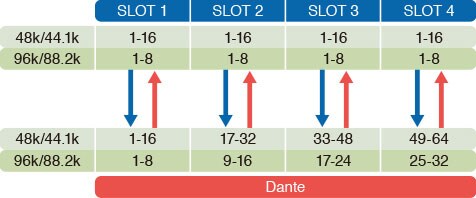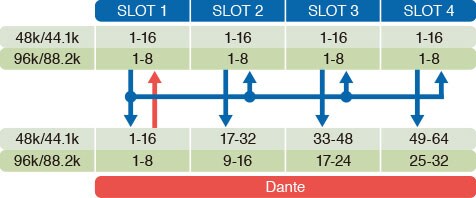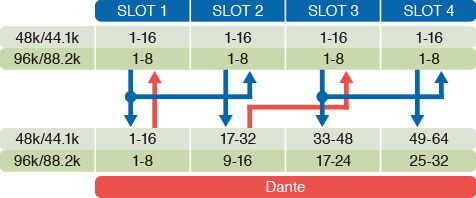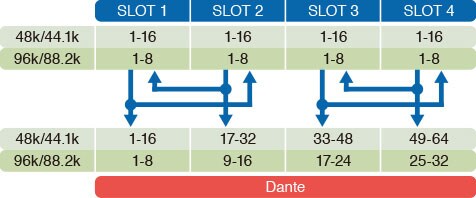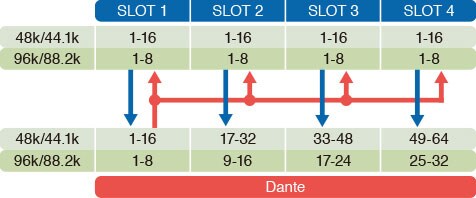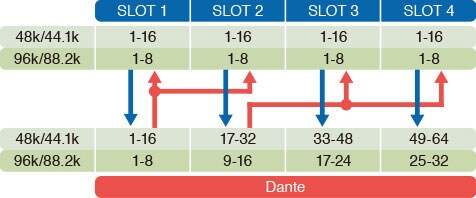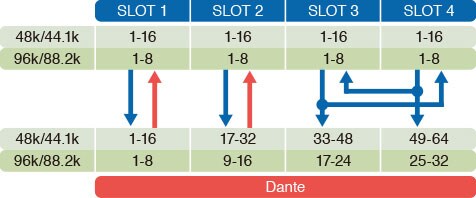PATTERN 1: Kết nối đầu vào và đầu ra của Dante và slot theo từng cặp một-một
Đây là mô hình định tuyến đơn giản nhất, trong đó các kênh của mạng Dante và slot được kết nối một-một để chuyển đổi trực tiếp giữa Dante và Mini-YGDAI. Mô hình này có thể được áp dụng trong nhiều trường hợp, chẳng hạn như kết nối tín hiệu Dante với ampli kỹ thuật số AES/EBU, chuyển đổi tín hiệu Dante sang định dạng AVIOM để sử dụng cho hệ thống kiểm âm cá nhân, đưa tín hiệu đầu vào AES/EBU vào mạng Dante, v.v. Một ứng dụng khác là lắp đặt thẻ MY8-LAKE để thực hiện xử lý Lake với đầu vào và đầu ra Dante.
PATTERN 2: Đầu vào Slot 1 phân phối đến Slot 2~4
Bên cạnh việc chuyển đổi từ thẻ Mini-YGDAI sang Dante, mẫu kết nối này còn hoạt động như một bộ chia tín hiệu âm thanh cho các thẻ Mini-YGDAI và có thể được sử dụng để chuyển đổi giữa các định dạng khác. Ví dụ, nếu một thẻ MY16-AE AES/EBU được lắp vào slot 1 và các thẻ ADAT hoặc EtherSound được lắp vào slot 2 đến 4, tín hiệu đầu vào AES/EBU có thể được chuyển đổi đồng thời sang định dạng Dante cũng như ADAT và/hoặc EtherSound, hỗ trợ tối đa ba định dạng đầu ra khác nhau. Với mẫu kết nối này, tín hiệu đầu vào ở slot 2 đến 4 cũng có thể được chuyển đổi sang định dạng Dante.
PATTERN 3: Đầu vào Slot 1 đến Slot 2 / Đầu vào Slot 3 đến Slot 4
Đây là phiên bản 2 x 32* kênh của Pattern 2. Ví dụ, với một thẻ MY16-ES64 EtherSound ở slot 1, một thẻ mở rộng I/O MY16-EX ở slot 3, và các thẻ MY16-AE AES/EBU ở slot 2 và 4, có thể chuyển đổi 32* kênh tín hiệu đầu vào EtherSound sang Dante, đồng thời chuyển đổi và phân phối đến đầu ra AES/EBU. Nếu sử dụng hai thiết bị RSio64-D, với thẻ MY16-EX ở slot 1 và 3, cùng thẻ MY16-AE ở slot 2 và 4 của thiết bị thứ hai, có thể chuyển đổi đồng thời 64* kênh EtherSound sang Dante và AES/EBU.* Ở tần số 48/44.1 kHz
PATTERN 4: Slot 1 và 2 kết nối hai chiều / Slot 3 và 4 kết nối hai chiều
Mô hình này cho phép chuyển đổi hai chiều giữa slot 1 và 2, cũng như giữa slot 3 và 4. Ví dụ, nếu một thẻ MY16-AT ADAT được lắp vào slot 1 và một thẻ MY16-AE AES/EBU được lắp vào slot 2, có thể thực hiện chuyển đổi hai chiều giữa ADAT và AES/EBU, đồng thời chuyển đổi từ ADAT và AES/EBU sang định dạng Dante. Slot 3 và 4 được cấu hình tương tự như slot 1 và 2. Ngoài ra, có thể lắp một thẻ MY8-LAKE để cung cấp xử lý Lake với nhiều lựa chọn định dạng đầu vào và đầu ra.
PATTERN 5: Dante inputs 1~16 phân phối đến tất cả các slot
Mô hình định tuyến này phân phối kênh Dante từ 1 đến 16* đến cả bốn slot Mini-YGDAI. Nếu cùng một loại thẻ được lắp vào cả bốn slot, hệ thống sẽ hoạt động như một bộ chia tín hiệu âm thanh đơn giản. Ngược lại, nếu các loại thẻ khác nhau được lắp vào, có thể vừa chia tín hiệu vừa chuyển đổi định dạng đồng thời. Một lợi ích khác là chỉ cần định tuyến 16* kênh Dante, giúp đơn giản hóa việc thiết lập. Mô hình này cũng cho phép chuyển đổi đầu vào từ bốn slot sang định dạng Dante. *Ở tần số lấy mẫu 48/44.1 kHz
PATTERN 6: Dante inputs 1~16* đến slot 1 và 2 / Dante inputs 17~32* đến slot 3 và 4
Mô hình định tuyến này cho phép đầu vào Dante từ 1 đến 32* được xuất ra dưới hai định dạng khác nhau. Ví dụ, Dante inputs 116* có thể được xuất ra ở định dạng AES/EBU qua slot 1 và ở định dạng ADAT qua slot 2. Đồng thời, Dante inputs 1732* có thể được xuất ra ở định dạng AES/EBU qua slot 3 và ở định dạng ADAT qua slot 4. Mô hình này cũng cho phép chuyển đổi đầu vào của bốn slot sang định dạng Dante. Ở tần số lấy mẫu 48/44.1 kHz
PATTERN 7: Dante 1~32* và slot 1, 2 kết nối một-một / Slot 3 và 4 kết nối hai chiều
Đây là sự kết hợp giữa Pattern 1 và Pattern 4 đã mô tả ở trên, cung cấp cả chuyển đổi trực tiếp đơn giản lẫn kết nối hai chiều giữa các slot. *Ở tần số lấy mẫu 48/44.1 kHz
